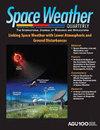Uncertainty Quantification for Machine Learning‐Based Ionosphere and Space Weather Forecasting: Ensemble, Bayesian Neural Network, and Quantile Gradient Boosting
IF 3.5
2区 地球科学
Q2 ASTRONOMY & ASTROPHYSICS
Space Weather-The International Journal of Research and Applications
Pub Date : 2023-10-01
DOI:10.1029/2023sw003483
引用次数: 0
Abstract
Abstract Machine learning (ML) has been increasingly applied to space weather and ionosphere problems in recent years, with the goal of improving modeling and forecasting capabilities through a data‐driven modeling approach of nonlinear relationships. However, little work has been done to quantify the uncertainty of the results, lacking an indication of how confident and reliable the results of an ML system are. In this paper, we implement and analyze several uncertainty quantification approaches for an ML‐based model to forecast Vertical Total Electron Content (VTEC) 1‐day ahead and corresponding uncertainties with 95% confidence intervals (CI): (a) Super‐Ensemble of ML‐based VTEC models (SE), (b) Gradient Tree Boosting with quantile loss function (Quantile Gradient Boosting, QGB), (c) Bayesian neural network (BNN), and (d) BNN including data uncertainty (BNN + D). Techniques that consider only model parameter uncertainties (a and c) predict narrow CI and over‐optimistic results, whereas accounting for both model parameter and data uncertainties with the BNN + D approach leads to a wider CI and the most realistic uncertainties quantification of VTEC forecast. However, the BNN + D approach suffers from a high computational burden, while the QGB approach is the most computationally efficient solution with slightly less realistic uncertainties. The QGB CI are determined to a large extent from space weather indices, as revealed by the feature analysis. They exhibit variations related to daytime/nightime, solar irradiance, geomagnetic activity, and post‐sunset low‐latitude ionosphere enhancement.基于机器学习的电离层和空间天气预报的不确定性量化:集合、贝叶斯神经网络和分位数梯度增强
近年来,机器学习(ML)越来越多地应用于空间天气和电离层问题,其目的是通过数据驱动的非线性关系建模方法来提高建模和预测能力。然而,对结果的不确定性进行量化的工作很少,缺乏对机器学习系统结果的信心和可靠性的指示。在本文中,我们实现并分析了几种不确定性量化方法,用于基于ML的模型,以95%置信区间(CI)提前1天预测垂直总电子含量(VTEC)和相应的不确定性:(a)基于ML的VTEC模型的超级集成(SE), (b)带有分位数损失函数的梯度树增强(QGB), (c)贝叶斯神经网络(BNN), (d)包括数据不确定性的BNN (BNN + d)。仅考虑模型参数不确定性(a和c)的技术预测的CI较低,结果过于乐观。而用BNN + D方法同时考虑模式参数和数据的不确定性,则可以获得更宽的CI和最现实的VTEC预测不确定性量化。然而,BNN + D方法具有较高的计算负担,而QGB方法是计算效率最高的解决方案,不确定性略低。特征分析表明,QGB CI在很大程度上是由空间天气指数决定的。它们表现出与白天/夜间、太阳辐照度、地磁活动和日落后低纬度电离层增强有关的变化。
本文章由计算机程序翻译,如有差异,请以英文原文为准。
求助全文
约1分钟内获得全文
求助全文
来源期刊
CiteScore
5.90
自引率
29.70%
发文量
166
审稿时长
>12 weeks
期刊介绍:
Space Weather: The International Journal of Research and Applications (SWE) is devoted to understanding and forecasting space weather. The scope of understanding and forecasting includes: origins, propagation and interactions of solar-produced processes within geospace; interactions in Earth’s space-atmosphere interface region produced by disturbances from above and below; influences of cosmic rays on humans, hardware, and signals; and comparisons of these types of interactions and influences with the atmospheres of neighboring planets and Earth’s moon. Manuscripts should emphasize impacts on technical systems including telecommunications, transportation, electric power, satellite navigation, avionics/spacecraft design and operations, human spaceflight, and other systems. Manuscripts that describe models or space environment climatology should clearly state how the results can be applied.

 求助内容:
求助内容: 应助结果提醒方式:
应助结果提醒方式:


